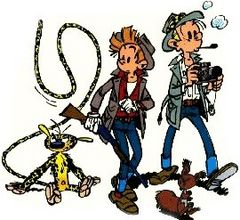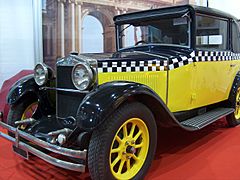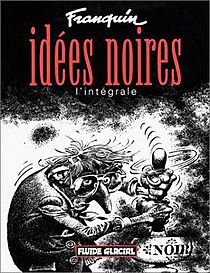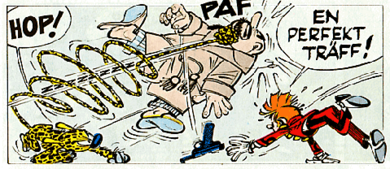André Franquin facts for kids
Quick facts for kids André Franquin |
|
|---|---|
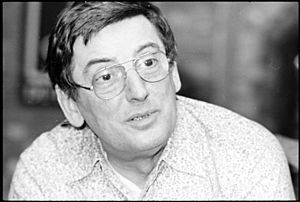
Franquin in 1979
|
|
| Born | 3 January 1924 Etterbeek, Belgium |
| Died | 5 January 1997 (aged 73) Saint-Laurent-du-Var, France |
| Nationality | Belgian |
| Area(s) | Writer, Artist |
|
Notable works
|
Spirou et Fantasio Modest et Pompon Gaston Idées noires Marsupilami |
| Awards | Full list |
| Signature | |
André Franquin (born January 3, 1924 – died January 5, 1997) was a very important comics artist from Belgium. He created famous characters like Gaston and the Marsupilami. He also drew the Spirou et Fantasio comic strip for over 20 years, from 1946 to 1968. Many people think this was the best time for the Spirou series.
Contents
Who Was André Franquin?
Franquin's Early Life and Art
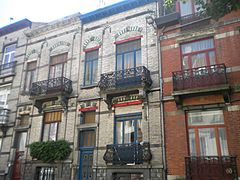
Franquin was born in Etterbeek, Belgium, in 1924. He started drawing when he was very young. In 1943, he took his first drawing lessons at École Saint-Luc. However, the school closed a year later because of the war.
Franquin then got a job at a short-lived animation studio in Brussels called Compagnie belge d'actualités (CBA). There, he met future famous artists like Maurice de Bevere (Morris, who created Lucky Luke), Pierre Culliford (Peyo, who created the Smurfs), and Eddy Paape.
After CBA closed in 1945, Franquin, Morris, and Paape were hired by Dupuis, a big publishing company. Peyo joined them later. Franquin began by drawing covers and cartoons for Le Moustique, a weekly magazine. He also worked for Plein Jeu, a scouting magazine.
During this time, Franquin and Morris learned a lot from Joseph Gillain (Jijé). Jijé had a special workspace in his house for young comics artists, including Franquin, Morris, and Will. This group was known as La bande des quatre (The Gang of Four). They developed a drawing style called the Marcinelle school. Marcinelle is a town near Charleroi, where Dupuis was located.
Taking Over Spirou et Fantasio
Jijé eventually gave the Spirou et Fantasio comic strip to Franquin. Franquin took over the series in June 1946. For the next 20 years, Franquin completely changed the strip. He created longer, more detailed stories and many funny characters.
One of his most famous creations is the Marsupilami. This is a fictional monkey-like creature with a super long, prehensile tail. Franquin got the idea for the tail from imagining an extra arm for busy tram conductors. The Marsupilami became very popular in Belgium and France. It led to cartoons, toys, and its own comic book series starting in 1989.
Franquin's Middle Period
By 1951, Franquin's drawing style was well-known. His comic strip was a big hit every week in Spirou magazine. Franquin also helped younger artists, like Jean Roba and Jidéhem, who worked with him on Spirou et Fantasio.
In 1955, Franquin briefly worked for a rival magazine called Tintin. There, he created Modeste et Pompon, a funny series. Other famous writers like René Goscinny (who created Astérix) and Peyo also contributed to it. Franquin later returned to Spirou, but he still had to work for both magazines. This was unusual in the comics world.
In 1957, the editor of Spirou, Yvan Delporte, suggested a new character to Franquin: Gaston Lagaffe. Gaston was first just a joke to fill empty space in the magazine. But the weekly comic strip, about a lazy office boy who caused funny accidents and had crazy ideas, became one of Franquin's most famous creations.
Around 1961-1963, Franquin went through a difficult time with his health. This made him stop drawing Spirou for a while. However, he continued to draw Gaston because it was a lighter, more humorous series.
In 1967, Franquin passed the Spirou et Fantasio series to a younger artist, Jean-Claude Fournier. Franquin then focused full-time on his own creations.
Over time, Gaston changed from just funny slapstick humor to include topics important to Franquin. These included pacifism (being against war) and environmentalism (protecting nature). Franquin continued to work on Gaston until he passed away.
Franquin's Later Work
In the 1960s, Franquin's drawing style changed. It became more free and detailed. This artistic change continued through the 1970s. Soon, Franquin was seen as a master of comics, just as famous as Hergé (the creator of Tintin). His influence can be seen in the work of almost every cartoonist who worked for Spirou magazine. Around 1970, early comic fan magazines featured Franquin's "Monsters," which were drawings of imaginary creatures that showed off his amazing drawing skills.
The biggest change in Franquin's work happened in 1977. He started his Idées Noires strip (meaning "Dark Thoughts"). It first appeared in a Spirou supplement and later in another magazine called Fluide Glacial. With Idées Noires, Franquin showed a more serious and sometimes sad side of his personality. These comics were drawn only in black and white. They were for an older audience and talked about topics like death, war, and pollution with a sharp, sarcastic humor.
From 1978 to 1986, Franquin helped create Isabelle. This comic was about a little girl in a world of witches and monsters. The character was named after Franquin's own daughter.
Franquin was very popular and respected. He won the first ever Grand Prix de la ville d'Angoulême in 1974. Many of his books are considered classics and have been translated into many languages. Several books have also been written about Franquin, including Et Franquin créa la gaffe, which is a long interview with him about his career.
Franquin passed away in 1997 in Saint-Laurent-du-Var at age 73 from a heart attack. In 2004, a big museum show of his work called "Le monde de Franquin" was held in Paris. This exhibit later came to Brussels, his hometown, in 2006. In 2005, a survey in Wallonia (a region in Belgium) voted him the "18th greatest Belgian ever."
Franquin's Influence on Comics
Franquin's drawing style was very different from Hergé's (the creator of Tintin). Hergé used clear lines and flat colors. Franquin's art became more colorful, used shadows, and showed a strong sense of movement. Hergé himself admired Franquin's work, saying, "Compared to him, I’m but a poor draftsman."
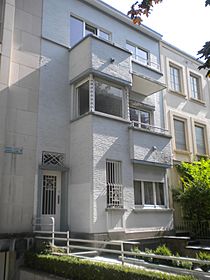
Franquin was a key member of the "Marcinelle School" of comics artists. This group included Morris and Will. Later, other artists like Peyo and Tillieux joined. Franquin had a huge influence on this group. Many artists who continued the Spirou et Fantasio series after he left, like Jean-Claude Fournier and Janry, tried to draw in Franquin's style.
Other artists from Belgium and France who were influenced by Franquin include Dino Attanasio and Mittéï (who took over Modeste et Pompon), Jidéhem (who worked with Franquin on Spirou et Fantasio and Gaston Lagaffe), Batem (artist for the Marsupilami series), and Pierre Seron.
Franquin also influenced Francisco Ibáñez, a very popular Spanish artist. Starting in the 1970s, Ibáñez used many ideas and designs from Franquin's comics. One of Ibáñez's characters, "El Botones Sacarino," is very similar to a mix of Spirou (a bellboy) and Gaston Lagaffe (he works in a publishing company and causes many problems).
Awards and Honors
- 1972: Prix Saint-Michel, Belgium, for Gaston Lagaffe
- 1974: First Grand Prix de la ville d'Angoulême, France (a very important comics award)
- 1980: Adamson Award, Sweden
- 1981: Prix Saint-Michel, Belgium, for Idées noires
- 1987: Grand Prix for the Graphic Arts at the Angoulême International Comics Festival
- 1991: Knight of the Order of Leopold, Belgium, for his long career
- 1996: Special Prize for outstanding life's work at the Max & Moritz Prizes in Erlangen, Germany
- 2017: Asteroid 293985 Franquin, discovered in 2007, was named in his memory.
See Also
 In Spanish: André Franquin para niños
In Spanish: André Franquin para niños


